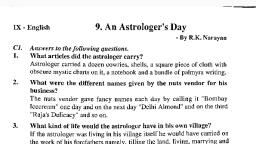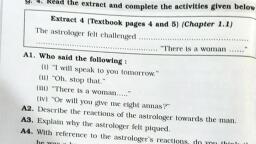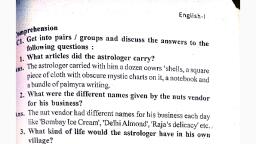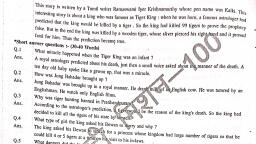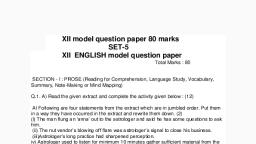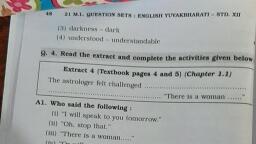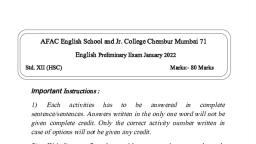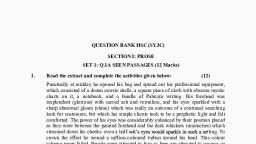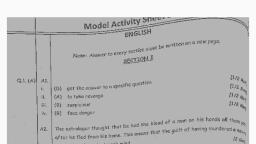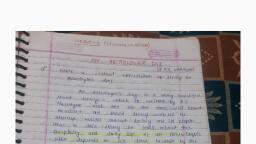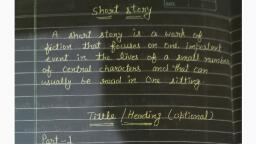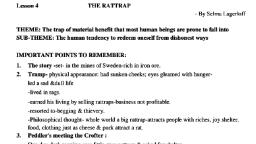Page 1 :
Chapter 8, , R. K. Narayan's, 'An Astrologer's Day', , About the author, R. K. Narayan, Rasipuram Krishnaswami Narayan (1906 - 2002) is one of the, best - known of Indian English writers. He was born and brought up in, Madras. He began by contributing items to a city newspaper. When, Punch accepted one of his pieces, he embarked in earnest on his, career as a novelist and a short story writer. His writings portray the, Indian ethos with remarkable simplicity and humor. He created the, fictional world of Malgudi. A winner of the Sahitya Akademi Award, (1960) and the Padma Vibhushan (2000), he was nominated for a, term in the Rajya Sabha. His novel, The Guide (1958), has been made, into a popular film. Narayan also wrote essays, both personal and, general, an autobiography (My Days, 1974), a travelogue (My, Dateless Diary, 1964) and retold Indian epics and myths (The, Ramayana, the Mahabharata and Gods, Demons and Others)., In addition to his fifteen novels, Narayan has written more than two, hundred short stories. He is a prolific writer whose works usually, culminate in an ironic twist. He declared, "Only the story matters that, are all … if a story is in tune completely with the truth of life, truth as I, perceive it, then it will be automatically significant.", , R. K. Narayan's 'An Astrologer's Day' / 239
Page 2 :
", , An Astrologer's Day" is a story about a man who runs away from, , his home and pretends to be an astrologer after imagining that he has, committed a murder. In a strange situation, an ironic twist of fate, he, runs into the very man he thought he had killed., 8.0, , Objectives, , 8.1, , Introduction, , 8.2, , Short Story as a form, , 8.3, , R.K. Narayan as a short story writer, , 8.4, , Theme of "An Astrologer's Day", , 8.5, , Summary of "An Astrologer's Day", , 8.6, , Conclusion, , 8.7, , Summary, - Answers to check your progress, - Field work, , 8. 0 Objectives, Friends, in this chapter we are going to study Short Story as a, form of Indian English Literature through the short story, 'An, Astrologer's Day' by R. K. Narayan,. The study of this chapter will, enable you to :, , ·, ·, ·, , Discuss short story as a form of literature., Narrate R. K. Narayan as a short story writer., Explain the style and various techniques used in the story under, discussion., , 8.1 Introduction, Friends, in the last chapter, we have studied one of the great, classic novels of Indian English Literature, i.e. Kanthapura written by, one of the big three early novelists of Indian English Literature, i.e.,, Raja Rao. The novel describes the simple rustic life of a South Indian, village, Kanthapura which undergoes a sea change when the, whirlwind of Gandhian freedom struggle reaches Kanthapura and the, village enthusiastically participates in the movement., , R. K. Narayan's 'An Astrologer's Day' / 240
Page 3 :
In the present chapter, we are moving from the novel to a short story,, 'An Astrologer's Day' by R. K. Narayan. The story deals with a day's, events in the life of a good for nothing fellow turned into an astrologer, to earn his bread and butter. A single day brings in his drastic past, back before him but being a smart fellow, he finely deals with it., , 8.2 Short Story as a form, Short Story signifies brevity, economy of words and short of, length. It is not just a story that is brief - it requires a particular kind of, literary construction. A broad analysis of a short story signifies three, characteristic elements:, 1. Recognition of the familiar : Vivid details to create the illusion, reality and actuality, of course, suggesting undercurrents, meaning. Though familiar, the writer has to rid it of any kind, banality, cliché or formula. A short story is, after all, not, transcription of life but a dramatization of life itself., , of, of, of, a, , 2. Empathy : Identifying ourselves very sympathetically and closely, with the characters and situations so as to feel a part of this, actuality - the well worn theme and thus get vivified by being, individualized and, 3. Readability : The good yarn pleasure tale - being absorbed by the, fascination of the tale, we are unable to put it down until we have, found out what happened. Of course, beyond the yarn lies a whole, range of meaning to be explored., The traditional notions associated with the short story such as, design, continuity, effect, change etc are essential ingredients of a, short story. Even without the formal narrative parameters, a story can, be exciting and evocative. Due to new fissures and new frictions, new, expectations and new equations at every level, personal, family, state,, national, international, the modern short story has traversed new, grounds both in content and form. A short story is a voyage of, discovery, of self - discovery, of self - realization for the character but, more than the character, for the reader., A short story has to have a formal plot or structure and the skill of, the author lies in making it appear as natural, as lifelike, and as, spontaneous as possible. The artist wants to make incidents or, situations appear natural rather than contrived. A well thought out plot, R. K. Narayan's 'An Astrologer's Day' / 241
Page 4 :
is one in which nothing is superfluous or superficial. A story has to, have a beginning and should convey a constant sense of movement., Therefore, an ideal structure would make the story interesting and true, to life as also build up suspense and arouse the reader's curiosity to, know what happens next or how the situation gets resolved at the end., It should also give meaning to the narrative., A good short story should strive for a unity of effect - a "single, effect". That is, a story should be compressed and economical the way, a poem is, free from digressions and irrelevancies and marked by its, intensity. It should be complete in itself and must have unity and, wholeness. A story is meant to be read at one sitting; a novel may take, days to read. So the story's effect must be sudden, powerful and, revealing whereas a novel can involve readers at a more leisurely, pace, slowly illuminating complexities and nuances., Stories also convey psychological reality. Much of what happens, in the modern story happens in the character's minds and in the, interior world. Therefore, in attempting to reveal the drama of human, consciousness, many modern writers have stopped stressing the, orderly progression of plots, have played down external action, and, have often abandoned photographic realism in favor of a more, complex psychological realism., In a short story, there is nothing to follow, nothing to look forward, to. The end of the short story is the end. It is marked by a sense of, finality, of definiteness, of tautness from beginning to end. It is self contained. Its compression induces a feeling of expanding into life, an, awareness of life expanding into our consciousness, enlarging our, consciousness. In this sense a short story imparts the sense of a, discovery., , 8.3 R. K. Narayan as a short story writer, R. K. Narayan is one of the three leading figures of early Indian, literature in English, along with Mulk Raj Anand and Raja Rao. He is, credited with bringing Indian literature in English to the rest of the, world and is regarded as one of the India's greatest Indian English, novelists. The setting for most of Narayan's stories is the fictional town, of Malgudi, first introduced in Swami and Friends. His narratives, highlight social context and provide a feel for his characters through, , R. K. Narayan's 'An Astrologer's Day' / 242
Page 5 :
everyday life. He has been compared to William Faulkner, who also, created a fictional town that stood for reality, brought out the humor, and energy of ordinary life and displayed compassionate humanism in, his writing. Narayan's short story writing style has been compared to, that of Guy de Maupassant as they both have an ability to compress, the narrative without losing out on elements of the story. With this, book, Narayan created Malgudi, a town that creatively reproduced the, social sphere of the country; while it ignored the limits imposed by, colonial rule. Malgudi also grew with the various socio-political, changes of British and post-independence India., He also published two collections of short stories: Malgudi Days, (1982), a revised edition including the original book and some other, stories and Under the Banyan Tree and Other Stories, a new, collection. Narayan's writing style was simple and unpretentious with, a natural element of humor about it. It focused on ordinary people,, reminding the reader of next-door neighbors, cousins and thereby, providing a greater ability to relate to the topic. Unlike his national, contemporaries, he was able to write about the intricacies of Indian, society without having to modify his characteristic simplicity to, conform to trends and fashions in fiction writing. He also employed the, use of nuanced dialogic prose with gentle Tamil overtones based on, the nature of his characters. Critics have considered Narayan to be, the Indian Chekhov, due to the similarities in their writings, the, simplicity and the gentle beauty and humor in tragic situations. Greene, considered Narayan to be more similar to Chekhov than any Indian, writer., According to Pulitzer Prize winner, Jhumpa Lahiri, Narayan's short, stories have the same captivating feeling as his novels, with most of, them less than ten pages long, and taking about as many minutes to, read. She adds that between the title sentence and the end, Narayan, provides the reader something novelists struggle to achieve in, hundreds more pages: a complete insight to the lives of his, characters. These characteristics and abilities led Lahiri to classify him, as belonging to the pantheon of short-story geniuses that include O., Henry, Frank O'Connor and Flannery O'Connor. Lahiri also compares, him to Guy de Maupassant for their ability to compress the narrative, without losing the story and the common themes of middle-class life, written with an unyielding and unpitying vision., , R. K. Narayan's 'An Astrologer's Day' / 243
Page 6 :
Critics have noted that Narayan's writings tend to be more descriptive, and less analytical; the objective style, rooted in a detached spirit,, providing for a more authentic and realistic narration. His attitude,, coupled with his perception of life, provided a unique ability to fuse, characters and actions and an ability to use ordinary events to create, a connection in the mind of the reader. A significant contributor to his, writing style was his creation of Malgudi, a stereotypical small town,, where the standard norms of superstition and tradition apply., Narayan's writing style was often compared to that of William, Faulkner since both their works brought out the humor and energy of, ordinary life while displaying compassionate humanism. The, similarities also extended to their juxtaposing of the demands of, society against the confusions of individuality. Although their approach, to subjects was similar, their methods were different; Faulkner was, rhetorical and illustrated his points with immense prose while Narayan, was very simple and realistic, capturing the elements all the same., There are some critics who find fault with Narayan for the ending of his, stories in an unconvincing way. Just like O'Henry, he ends some of his, stories with a 'sudden reversal of situation.', Narayan's greatest achievement was making India accessible to, the outside world through his literature. He is regarded as one of the, three leading Indian English language fiction writers, along with Raja, Rao and Mulk Raj Anand. He gave his readers something to look, forward with Malgudi and its residents and is considered to be one of, the best novelists India has ever produced. He brought small-town, India to his audience in a manner that was both believable and, experiential. Malgudi was not just a fictional town in India but one, teeming with characters, each with their own idiosyncrasies and, attitudes, making the situation as familiar to the reader as if it were, their own backyard., , 8.4 Theme of "An Astrologer's Day", The theme of the story focuses on a single day in the life of an, ordinary astrologer who suddenly faces past life in the present drastic, situation. The story has a twist in the tale. The otherwise adventure, less life of the astrologer suddenly poses a grave problem from his, past life and demands alertness to tackle the situation. The story, , R. K. Narayan's 'An Astrologer's Day' / 244
Page 7 :
describes of a single day in the lives of the sleepy town of Malgudi., The story also deals with the darker side of human nature with its, hypocrisies, shrewdness, revengeful nature and selfishness. The, characters in the story are no exception to these qualities of human, nature. Finally all is well that ends well with the astrologer coming out, with flying colors in his examination of befooling his opponent, saving, his life and also saw to it that he does not face the man again in future., , 8.5 Summary of "An Astrologer's Day", "The Astrologer's Day" is a short story which deals with a day in, the life of an ordinary but fake astrologer. The setting of the story is a, town, Malgudi which is located in South India, near to Madras. It is not, a story of contemporary times but pre - independence times., The story opens at the midday. This is the time when the, astrologer opens his business. The writer describes how he begins his, business. He removes all his professional equipment like cowries, shells, charts, Palmyra writing etc. He is also dressed typically like an, astrologer to attract customers. His forehead is bright with sacred ash, and vermilion. His eyes are assumed to have a prophetic light by his, customers. He wears a saffron turban. Thus the astrologer presented, himself so perfectly that he was consequently a point of attraction for, all the people., The writer describes the path along the Town Hall Park where the, astrologer sits to lure his prospective customers. He carried on his, business under a tamarind tree on the Town Hall road. The path was, the right place to carry on his business as it was amply crowded with, different trades and traders like medicine sellers, hardware and junk,, magicians, cloth - sellers etc. Next to him sat a fried groundnut vendor, whose gas light enabled him to carry on his business even after, sunset., The astrologer was a shrewd person who hardly had any, knowledge of astrology. He just made a guess work when people, approached him. He had to work hard to earn his wages. He had, absconded from his native village since he didn't want to continue the, traditional occupation of his forefathers i.e. farming. He never had any, plans to return to his native village., He was a mastermind at analyzing human mind and psychology., , R. K. Narayan's 'An Astrologer's Day' / 245
Page 8 :
His strong perception made him diagnose the exact problem of his, customers. His customers would finally leave satisfied., He closed his shop for the day when his neighbor, groundnut, vendor blew out his light. On the day under description in the story, the, groundnut vendor left and the astrologer was packing up his wares, when he located a man standing before him. He perceived him to be, his prospective customer. When the astrologer invited him, he posed, a challenge before him and his astrological science. They have a deal, between them. The man gave him an anna and asked the astrologer, to answer his questions and if he doesn't answer satisfactorily he will, have to return the anna with interest. At the same time if the astrologer, is able to answer the questions satisfactorily he would give him eight, annas. But if the astrologer fails, he would pay double amount i.e.,, sixteen annas to the man. Thus the deal was finalized between them., The astrologer prayed to the heaven. Then suddenly the astrologer, denied the challenge and requested the man to let him go. The man, said that he will not let him give in. He holds him in his grip thereby, making the astrologer shiver. Finally, the astrologer realized that he is, trapped and has no chance of moving out. The man turned out to be, a criminal by profession., The astrologer shivered and unwillingly accepted the challenge., He started telling about some woman but the man was not satisfied, and stopped him. He had a single question that whether he would get, what he was searching for. The man promised the astrologer that if he, is satisfied with his answers, he would pay him a rupee. The astrologer, prayed a few incantations before replying. The astrologer began with, his prophecies by saying to the man that you were left for dead in the, past and a knife has passed once on your chest. The man was excited, at this information since he had really faced it. After he got wounded,, he was thrown into a well nearby to die. A passerby saw him and, rescued him and that is how he was saved from dying. The man was, waiting to revenge the culprit who had attacked him and was in search, of the culprit who had tried to kill him. The only thing which the man, wanted to know from the astrologer was if he can find his killer., The astrologer instantly replied that the culprit had died four, months ago in a far - off town. The man was disappointed to hear this., The astrologer identified the name of the man before him as Guru, Nayak. He told the man that his village was a two days' journey to, R. K. Narayan's 'An Astrologer's Day' / 246
Page 9 :
north and warned him to go back home and never to travel south, again. He asked him to return to his hometown immediately as his life, was in danger if he left his hometown again. The man replied that he, left home just to search the culprit who had tried to kill him and was, interested in knowing if he had died in a worst way. The astrologer, satisfied him by informing that the culprit was crushed under a lorry., The man left after giving the astrologer a handful of coins. The, astrologer too winded up his belongings and went home., The astrologer's wife was waiting for him worriedly since he was, unusually late that day. The astrologer flung the coins at his wife to, count. They were twelve and a half annas in all. She was extremely, happy to encounter that big amount. She planned to buy jaggery and, coconut for their child, who was demanding for sweets from a long, time. However, the astrologer looked worried and was not happy like, his wife. He was angry at Guru Nayak as he had cheated him. He, promised to give a rupee and actually gave only twelve and a half, annas. After dinner, he shared the secret of his life with his wife. He, said that a great burden of his life was gone that day. He always felt, that he had killed Guru Nayak. So the astrologer had run away from, his native village due to the fear of being accused as a murderer. He, settled in Malgudi and married and decided that he would never return, back to his native village. Actually the man who tried to kill Guru Nayak, was the astrologer himself. So he was able to make accurate, predictions about him though he hardly knew astrology. The astrologer, confessed to his wife that in his youth he was into bad company with, Guru Nayak. He drank, gambled and quarreled badly one day and had, a fight and had almost killed Guru Nayak., This is how life with its unpredictable twists and turns had created, an astrologer out of a vagabond., , Check your progress, A. Choose the correct alternative :, 1. From the twelve and a half annas that the astrologer earned, his, wife planned to, a. Buy fruits b. Buy vegetables c. Make sweets, 2. To answer his questions, the man first gave the astrologer, a. Three pies b. Four pies c. Five pies, , R. K. Narayan's 'An Astrologer's Day' / 247
Page 10 :
3. The astrologer was able to please customers because of, a. His humor b. His honesty c. His clever guessing, , B. The story contains synonyms of the expressions given, below. Locate them in the text and write them down:, 1. Bright red in color, 2. Expressing opinions or feelings in a loud and confident way, 3. Willing or prepared to do something, 4. Words that are spoken or sung to have a magical effect, 5. With no people in it, , C. Read the story carefully and find single words for each of, the phrases given below:, 1. Bright and colorful in an impressive way, 2. To hang about aimlessly, 3. Showing good judgement and likely to be right, 4. Acting without thinking of results, 5. A large number of objects or personal possessions, , D. The story contains the antonyms of the words given below., Locate them in the text and write them down., 1. Amateur, 2. Unremarkable, 3. Guilty, 4. Interior, 5. Safety, , E. Answer the following questions :, 1. When did the astrologer usually start his day's business?, 2. Why did the astrologer think he had committed a murder?, 3. What mark did Guru Nayak have on his chest?, 4. How much money did the astrologer usually charge per, question?, R. K. Narayan's 'An Astrologer's Day' / 248
Page 11 :
5. What made the astrologer's forehead look grand?, 6. How did the astrologer know the name of his customer?, 7. Describe the place where the astrologer set up his daily, business., , 8.6 Conclusion, Overall in this chapter, the short story 'An Astrologer's Day', describes about a single day in the life of the astrologer. The story has, suspense and a twist in the tale towards the end. The story also uses, the co - incidence factor where the astrologer is shocked and is hardly, able to cope with the situation. His alertness of mind and smartness, as an astrologer come to his rescue. Finally, he is freed from the, burden of killing Guru Nayak., The next chapter deals with the post - modern novel, A Fine, Balance of the diasporic writer, Rohinton Mistry., , 8.7 Summary, The short story 'An Astrologer's Day' by R. K. Narayan deals with, a single day in the life of an ordinary astrologer. His day begins as any, other day but the day ends with unexpected events. When he is about, to wind up his business, he meets a rogue character, Guru Nayak who, is a part of the past life of the astrologer. Towards the end, as readers,, we receive a shock that Guru Nayak and the astrologer belong to the, same native towns. They were once upon a time good friends and had, a quarrel one day. The result was that both were into bad company, and had a fight. The astrologer tried to kill Guru Nayak by attacking, him with a knife and when Guru Nayak fainted, he threw him into a, nearby well. Fortunately, a passerby saved Guru Nayak. The, astrologer left his native village forever and became an astrologer., Thus suddenly he confronts his past unexpectedly but smartly tackles, the situation., , Answers to check your progress, A. Choose the correct alternative :, 1. - C, , R. K. Narayan's 'An Astrologer's Day' / 249
Page 12 :
2. - A, 3. - C, , B. The story contains synonyms of the expressions given, below. Locate them in the text and write them down :, 1. Vermilion, 2. Vociferousness, 3. Dallied, 4. Incantations, 5. Deserted, , C. Read the story carefully and find single words for each of the, phrases given below :, 1. Resplendent, 2. Surging, 3. Shrewd, 4. Impetuous, 5. Paraphernalia, , D. The story contains the antonyms of the words given below., Locate them in the text and write them down., 1. Professional, 2. Remarkable, 3. Proud, 4. Exterior, 5., , Dangerous, , E. Answer the following questions:, 1. Punctually at midday the astrologer usually started his day's, business., 2. The astrologer had a fight with Guru Nayak and had thrown him in, a well and he supposed him to be dead. So the astrologer thought, he had committed the murder of Guru Nayak., , R. K. Narayan's 'An Astrologer's Day' / 250
Page 13 :
3. Guru Nayak had a mark of injury of knife on his chest., 4. The astrologer usually charged three pies per question., 5. The astrologer's forehead was resplendent with sacred ash and, vermilion and his eyes sparkled with abnormal gleam and this, made the astrologer's forehead look grand., 6. The astrologer knew the name of his customer because he was, from his hometown and an old friend of him., 7. The astrologer set up his daily business at a path running through, the Town Hall Park. He sat under the boughs of a spreading, tamarind tree which flanked a path running through the Town Hall, Park. It was remarkable in many ways: a surging crowd was, always moving up and down this narrow road morning till night. A, variety of trades and occupations was represented all along its way, : medicine sellers, sellers of stolen hardware and junk, magicians, and above all, an auctioneer of cheap cloth, who created enough, din all day to attract the whole town. Next to him in vociferousness, came a vendor of fried groundnut, who gave his ware a fancy came, each day, calling it "Bombay Ice Cream" one day, and on the next, "Delhi Almond" and on the third "Raja's Delicacy", and so on and, so forth and people flocked to him. A considerable portion of this, crowd dialed before the astrologer too. The astrologer transacted, his business by the light of a flare which crackled and smoked up, above the groundnut heap nearby. The place was lit up by shop, lights. It was a bewildering criss - cross of light rays and moving, shadows. In short, the place was perfect for the astrologer's, business., , Field work, Read the stories of other contemporary short story writers like, Mulk Raj Anand and compare them with the stories of R. K .Narayan., Try to study the difference in their techniques of story writing., , ❑❑❑, , R. K. Narayan's 'An Astrologer's Day' / 251





